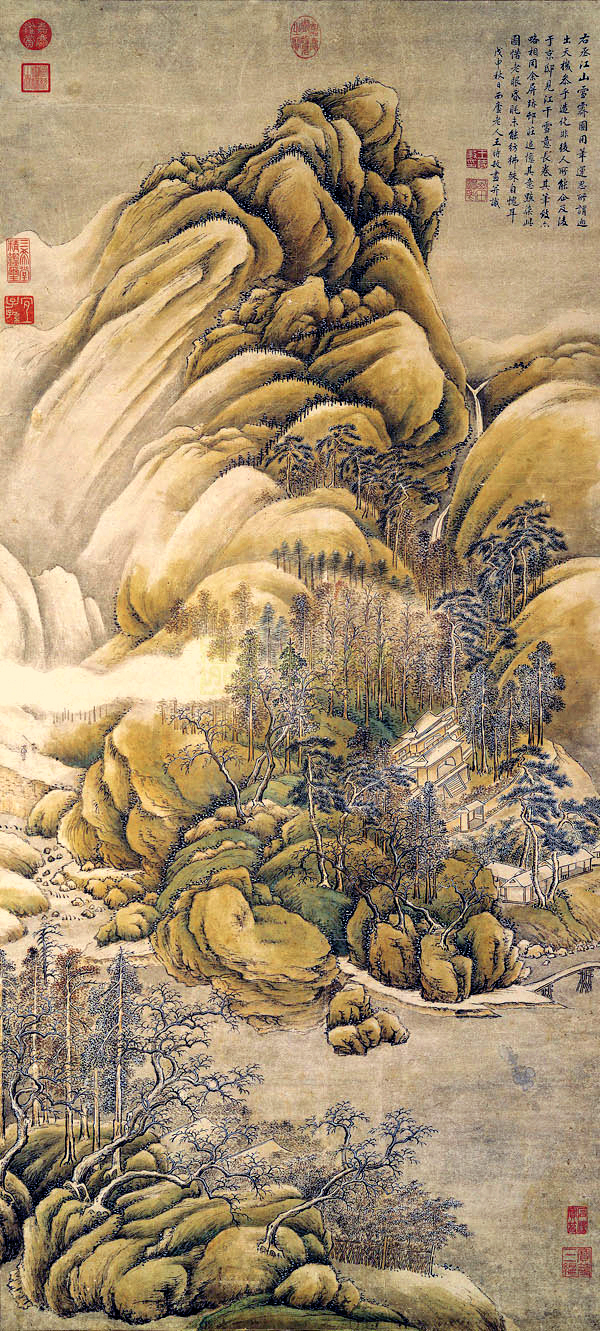Wang Shimin on:
[Wikipedia]
[Google]
[Amazon]
 Wáng Shímǐn (; c. 1592–1680) was a Chinese
Wáng Shímǐn (; c. 1592–1680) was a Chinese
Landscapes Clear and Radiant: The Art of Wang Hui (1632-1717)
an exhibition catalog from The Metropolitan Museum of Art (fully available online as PDF), which contains material on Wang Shimin (see index) 1590s births 1680 deaths Ming dynasty landscape painters Qing dynasty landscape painters Painters from Suzhou Politicians from Suzhou Ming dynasty politicians 17th-century Chinese painters People from Taicang {{China-painter-stub
 Wáng Shímǐn (; c. 1592–1680) was a Chinese
Wáng Shímǐn (; c. 1592–1680) was a Chinese landscape painter
Landscape painting, also known as landscape art, is the depiction of natural scenery such as mountains, valleys, trees, rivers, and forests, especially where the main subject is a wide view—with its elements arranged into a coherent compos ...
during the late Ming Dynasty
The Ming dynasty (), officially the Great Ming, was an Dynasties in Chinese history, imperial dynasty of China, ruling from 1368 to 1644 following the collapse of the Mongol Empire, Mongol-led Yuan dynasty. The Ming dynasty was the last ort ...
and early Qing Dynasty
The Qing dynasty ( ), officially the Great Qing,, was a Manchu-led imperial dynasty of China and the last orthodox dynasty in Chinese history. It emerged from the Later Jin dynasty founded by the Jianzhou Jurchens, a Tungusic-speak ...
(1644–1911).
Born in the Jiangsu
Jiangsu (; ; pinyin: Jiāngsū, Postal romanization, alternatively romanized as Kiangsu or Chiangsu) is an Eastern China, eastern coastal Provinces of the People's Republic of China, province of the China, People's Republic of China. It is o ...
province, Wang grew up in an artistic, scholarly environment. His grandfather was a prime minister in the late Ming dynasty, and his father was a Hanlin Academy
The Hanlin Academy was an academic and administrative institution of higher learning founded in the 8th century Tang China by Emperor Xuanzong in Chang'an.
Membership in the academy was confined to an elite group of scholars, who performed sec ...
editor for the court, who had studied with Tung Ch'i-ch'ang. After learning painting and calligraphy
Calligraphy (from el, link=y, καλλιγραφία) is a visual art related to writing. It is the design and execution of lettering with a pen, ink brush, or other writing instrument. Contemporary calligraphic practice can be defined as "t ...
at a young age, Wang worked as a government official. However he fell ill due to exhaustion on a trip to Nanking
Nanjing (; , Mandarin pronunciation: ), alternately romanized as Nanking, is the capital of Jiangsu province of the People's Republic of China. It is a sub-provincial city, a megacity, and the second largest city in the East China region. T ...
in 1630. Wang returned to his homeland and immersed himself in art, creating numerous works. Wang's works place him in an elevated group known as the Four Wangs
The Four Wangs () were four Chinese landscape painters in the 17th century, all with the surname Wang. They are best known for their accomplishments in ''shan shui'' painting.
The painters
They were Wang Shimin (1592–1680), Wang Jian (159 ...
, also part of the Six Masters of the early Qing period
The Six Masters of the early Qing period () were a group of major Chinese artists who worked in the 17th and early 18th centuries during the Qing dynasty. Also known as orthodox masters, they continued the tradition of the scholar-painter, followi ...
.
Wang painted ''After Wang Wei's "Snow Over Rivers and Mountains"'', which can be viewed at the National Palace Museum
The National Palace Museum (; Pha̍k-fa-sṳ: Kwet-li̍p kù-kiung pok-vu̍t-yèn), is a museum in Taipei, Republic of China (Taiwan). It has a permanent collection of nearly 700,000 pieces of Chinese artifacts and artworks, many of which wer ...
, Taipei.
Wang was the grandfather and tutor of Wang Yuanqi
Wang Yuanqi (; pinyin: Wáng Yuánqí; 1642–1715) was a Chinese painter of the Qing dynasty.
Wang was born in Taicang in the Jiangsu province and tutored in painting by his grandfather Wang Shimin (1592–1680). His style name was 'Mao-ching' ...
(; 1642–1715), who was also a notable landscape painter and a member of the Six Masters of the early Qing period
The Six Masters of the early Qing period () were a group of major Chinese artists who worked in the 17th and early 18th centuries during the Qing dynasty. Also known as orthodox masters, they continued the tradition of the scholar-painter, followi ...
.
References
*External links
Landscapes Clear and Radiant: The Art of Wang Hui (1632-1717)
an exhibition catalog from The Metropolitan Museum of Art (fully available online as PDF), which contains material on Wang Shimin (see index) 1590s births 1680 deaths Ming dynasty landscape painters Qing dynasty landscape painters Painters from Suzhou Politicians from Suzhou Ming dynasty politicians 17th-century Chinese painters People from Taicang {{China-painter-stub